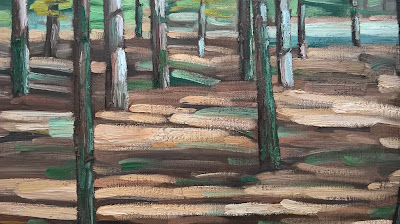Following-on from the recent ‘in progress’ report (‘Digesting October…’), today we present the first painting of our local woodland subsequently brought to some form of resolution over the course of Saturday afternoon spent listening to the 2 CDs of ‘The Essential Leonard Cohen’, but a selection in celebration of the work of the songwriter supreme ‘born with the gift of the golden voice’ (at least in the guise of the narrator of the mighty ‘Tower of Song’), whose passing has sadly been announced – many fine words have been written in tribute, not least on the Guardian website on & from Friday, also including Gerry’s on his ‘That’s How The Light Gets In’ blog, another to follow avidly. The recordings left behind, of such exquisitely-crafted & masterfully-performed songs, will resonate down the years, of that there can be no doubt.
‘Woods #1’
oil on canvas/24″ x 48″/October-November 2016
The painting itself, as ‘finished’, probably achieves something of what was intended whilst leaving plenty of scope for development. Formally and, from that, technically it observes the obvious horizontals and verticals of the subject matter and represents a ‘tactile space’, independently as a painting and as analogous to the physical experience of being actively present in the landscape (treading upon the pine needle-covered and mossy ground whilst the tall straight columns of the trees confront as one navigates a path through and tower overhead), treating figure and ground with equal gestural weight in the pursuit of a more integrally ‘overall’ painterly surface where, striving to achieve that balance between facture and image, the means of representation and that represented, ‘the paint is tree and the tree is paint’ to paraphrase either Ivon Hitchens himself or otherwise something that was written about his work (precise memory fails). It must be admitted that, once exposed to (the potential of the influence of), one sees the scene(s) through Hitchens’ compositions, those spatial sequences and intervals across a wider panoramic or ‘cinematic’ format, and this of course inevitably lends itself to a particular aspect of the appearance of the painting, characterised as it is in part by more elongated swiping brushstrokes.
(detail)
(detail)
(detail)
(detail)
(detail)

























